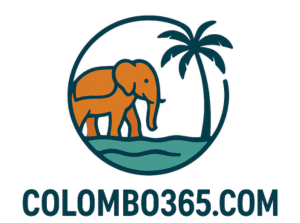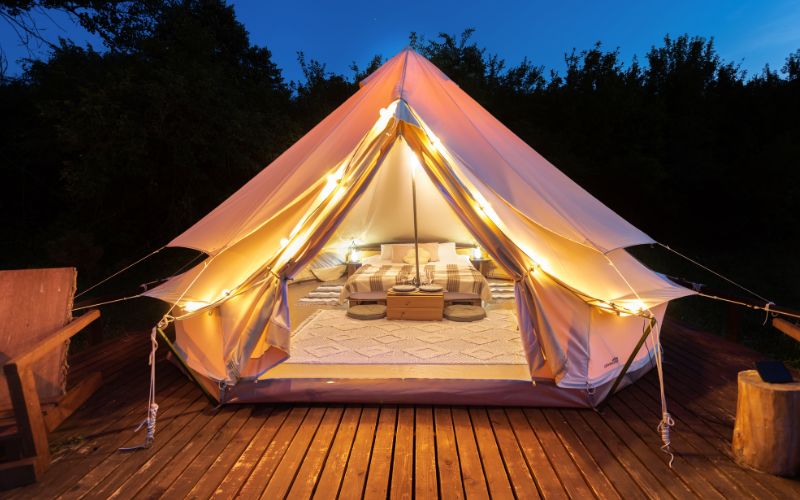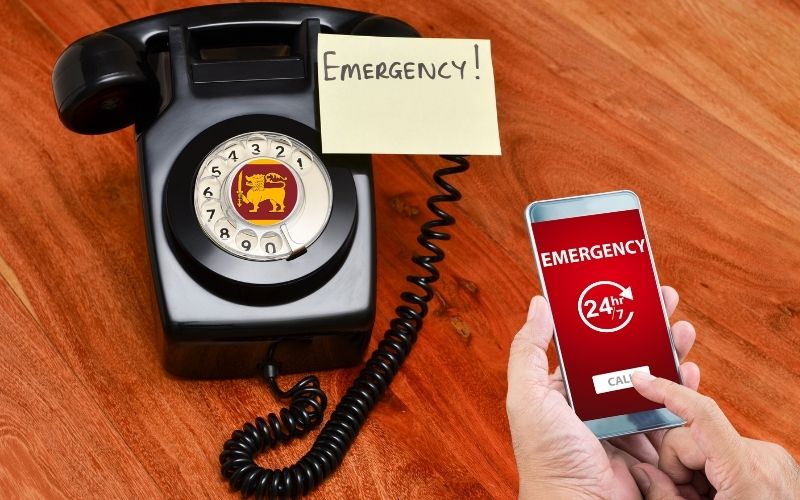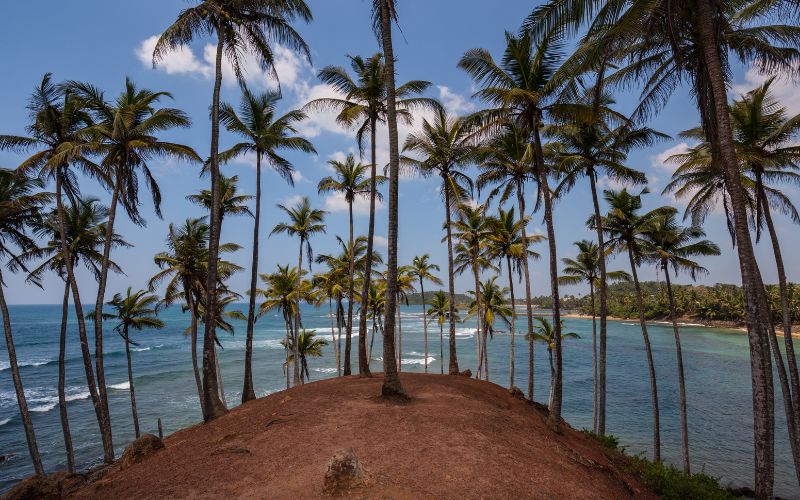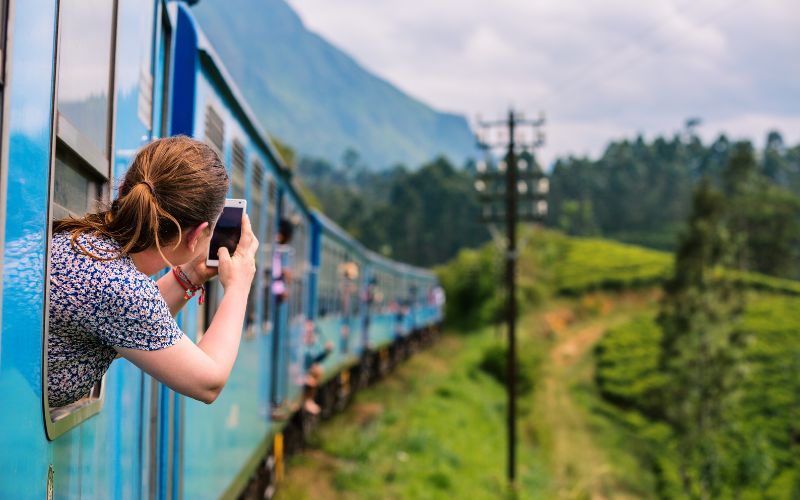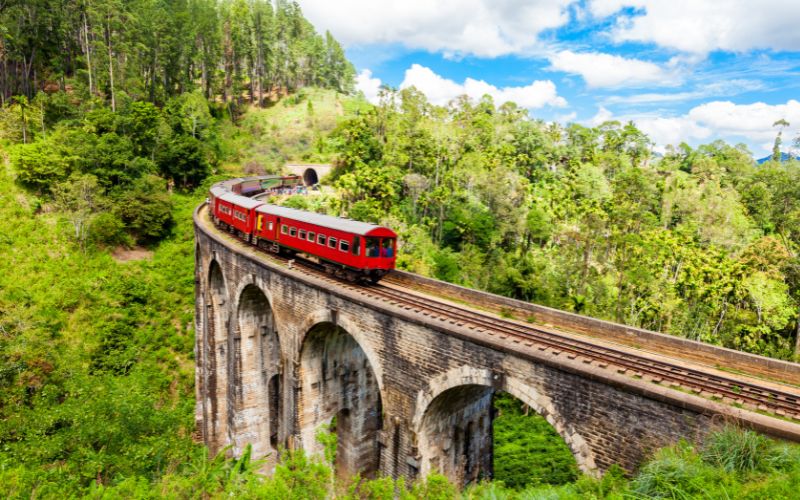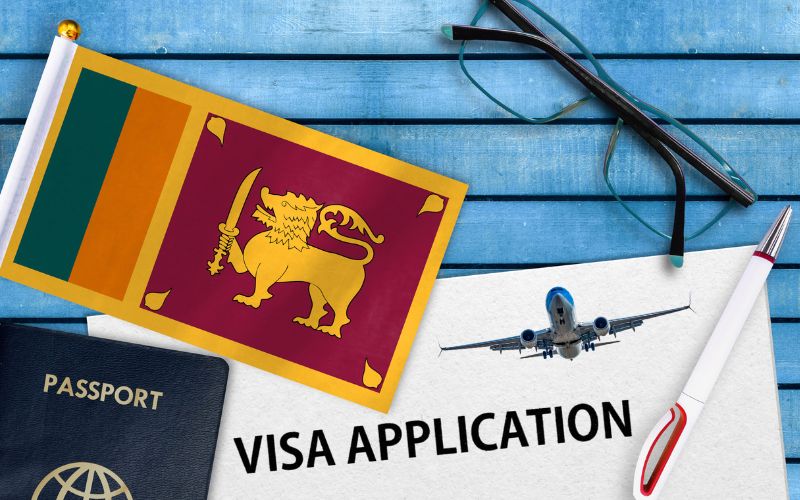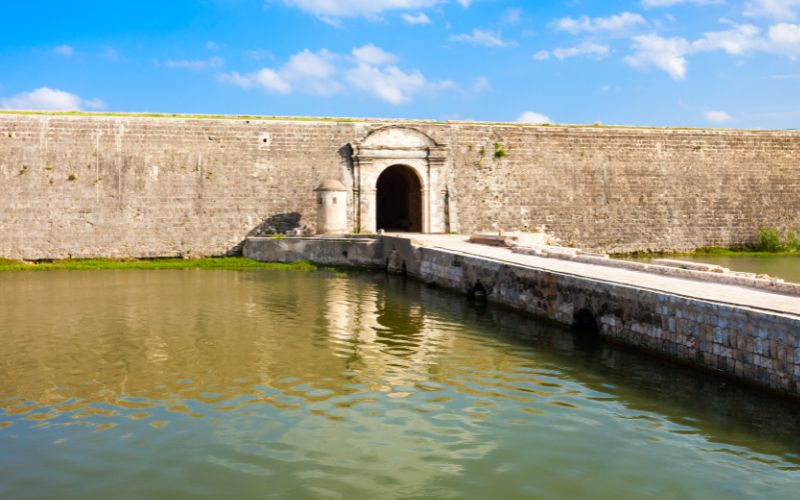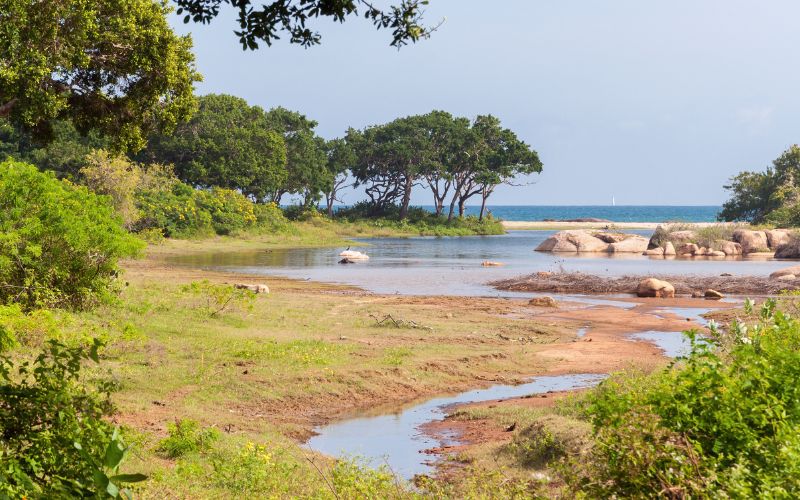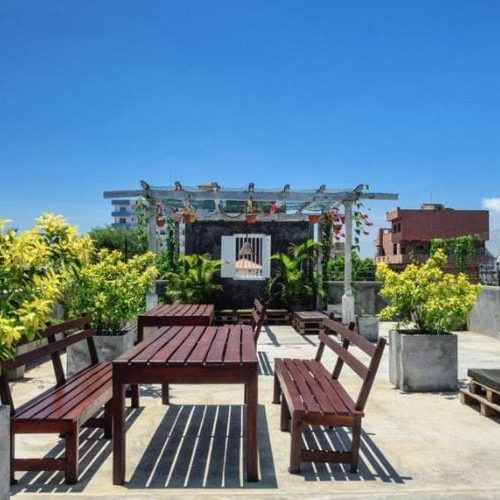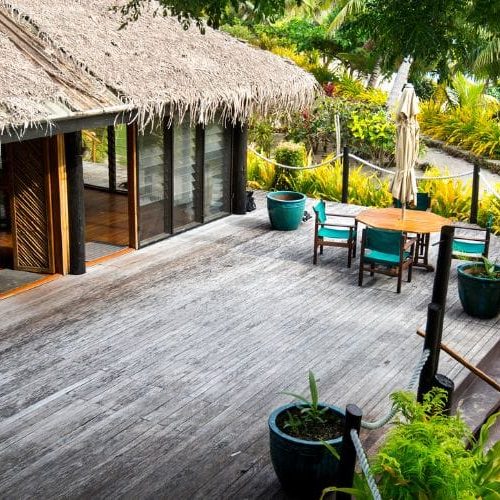Camping in Sri Lanka Glamping in Sri Lanka Unique Camping and Glamping Experiences Sri Lanka offers a unique blend of outdoor experiences, from traditional camping to luxurious glamping, allowing travelers to connect with nature in stunning settings. Whether you prefer sleeping under the stars in a tent or enjoying the comforts of a luxury tented camp, Sri Lanka’s diverse landscapes provide a perfect backdrop for outdoor adventures. Camping in Sri Lanka For nature lovers and adventurers, traditional camping is an incredible way to explore the island’s natural beauty. From national parks to mountains, there are several pristine spots ideal for setting up a tent and enjoying the serenity of the wild. Yala National Park: Known for its wildlife, especially leopards and elephants, camping in Yala provides an authentic wilderness experience. Campsites are located near the park’s boundaries, allowing campers to immerse themselves in nature. Wilpattu National Park: The largest national park in Sri Lanka, Wilpattu is famous for its lakes and remote beauty. Camping here is a peaceful retreat, offering a chance to spot wildlife such as leopards, sloth bears, and elephants. Horton Plains National Park: For hikers and trekkers, Horton Plains offers some of the best high-altitude camping in Sri Lanka. Set amidst misty forests and grasslands, camping here provides access to the famous World’s End viewpoint. Knuckles Mountain Range: For those seeking a rugged and remote camping experience, the Knuckles Range offers challenging trails and secluded campsites. The area is a UNESCO-listed biosphere reserve, rich in biodiversity. Ella: The scenic hill town of Ella is surrounded by tea plantations and forests, making it a popular spot for camping. Campers can enjoy stunning views of Ella Gap and hike to attractions like Little Adam’s Peak. Glamping in Sri Lanka For travelers who want to experience the great outdoors without sacrificing comfort, glamping offers the best of both worlds. Luxurious tented camps provide modern amenities such as cozy beds, en-suite bathrooms, and gourmet meals, all while being close to nature. Mahoora Tented Safari Camps (Yala, Udawalawe, Wilpattu) Mahoora offers high-end glamping experiences in some of Sri Lanka’s most popular national parks. With spacious tents, private decks, and personalized service, guests can enjoy wildlife safaris during the day and luxury accommodations by night. Wild Coast Tented Lodge (Yala) This eco-luxury camp is located on the edge of Yala National Park, offering domed tents that blend seamlessly into the rugged coastal landscape. The lodge features a swimming pool, spa, and gourmet dining, providing an unforgettable glamping experience. Gal Oya Lodge Located near Gal Oya National Park, this eco-friendly lodge offers a unique glamping experience with spacious safari tents. Guests can explore the park, go on boat safaris, and immerse themselves in the untouched beauty of the region. Leopard Safaris by KK Collection (Yala & Wilpattu) Offering luxurious glamping experiences, Leopard Safaris combines adventure with comfort. Their mobile camps are set up in stunning wilderness locations, providing high-quality service and accommodation. Back of Beyond Camps (Pidurangala & Sigiriya) These eco-lodges offer a glamping experience near two of Sri Lanka’s most iconic landmarks, Pidurangala and Sigiriya. Guests stay in spacious, eco-friendly tents nestled in the jungle, providing a peaceful retreat after exploring the ancient sites. Unique Camping & Glamping Experiences Riverstone Camping (Matale) This off-the-beaten-path camping destination offers a tranquil experience in the Knuckles Mountain Range. Campers can hike through forests and streams, spot waterfalls, and enjoy the scenic beauty of the area. Kitulgala Adventure Camps Kitulgala is a hub for outdoor adventure sports, including white-water rafting, abseiling, and trekking. Several campsites in the area provide a rustic camping experience, complete with adventure activities. Sinharaja Rainforest Camping Experience the rich biodiversity of Sri Lanka’s only tropical rainforest by camping in Sinharaja. Campsites are surrounded by dense vegetation, and guests can enjoy guided treks to spot endemic birds, reptiles, and insects. Kumana National Park Kumana is a birdwatcher’s paradise, offering secluded camping amidst nature. The park is home to hundreds of bird species, making it a tranquil destination for bird lovers and nature enthusiasts. Beach Camping (Arugam Bay & Kalpitiya) For a different kind of camping experience, beach camping offers a peaceful escape by the sea. Arugam Bay and Kalpitiya are popular spots where campers can enjoy the sound of the waves and the beauty of Sri Lanka’s coastline. Camping and glamping in Sri Lanka offer unforgettable ways to experience the island’s natural beauty. Whether you prefer the simplicity of traditional camping or the luxury of a glamping retreat, there are options to suit all preferences.
Emergency Contacts in Sri Lanka
General Emergency Numbers Hospitals and Medical Services Foreign Embassy Contacts Local Assistance Other Important Contacts Mobile Network Emergency When traveling in Sri Lanka, it’s essential to know the key emergency contacts for quick assistance. Whether it’s a medical emergency, police assistance, or consular help, here is a list of important numbers and services to keep on hand: General Emergency Numbers Police Emergency: 119: For any situation requiring police assistance, such as accidents, theft, or safety issues, dial 119. Ambulance & Medical Emergencies: 1990 (Suwasariya): The 1990 Suwasariya ambulance service provides free emergency medical services across the country. Fire Brigade: 110: In case of fire, call the national fire service for rapid assistance. Tourist Police: 0112421052: The Tourist Police unit assists visitors with any issues, including lost items, harassment, or tourist-related crimes. Located in Colombo but active in tourist areas as well. Hospitals and Medical Services Government Hospitals National Hospital of Sri Lanka (Colombo): 0112691111: The largest and most advanced medical facility in Sri Lanka, offering a wide range of medical services for emergencies. Castle Street Hospital for Women, Colombo (Castle Street, Colombo 08, 0112696231) Colombo South Teaching Hospital, Kalubowila (B229 Hospital Road, Kalubowila, Dehiwala, 0112832950) Dental Institute, Colombo De Soysa Hospital for Women (De Soysa Maternity Hospital), Colombo Lady Ridgeway Hospital for Children, Colombo National Cancer Institute, Maharagama National Eye Hospital, Colombo National Institute of Mental Health (Angoda Mental Hospital), Angoda Sri Jayawardenepura General Hospital, Sri Jayawardenepura Infectious Disease Hospital (Fever Hospital), Angoda Mulleriyawa Base Hospital (Colombo East General Hospital), Mulleriyawa Borella Prison Hospital, Borella Colombo Military Hospital, Colombo Colomb Naval Hospital, SLNS Parakrama, Colombo Panagoda Base Hospital, Panagoda Cantonment Police Hospital, Colombo Avissawella Base Hospital, Avissawella Homagama Base Hospital, Homagama Piliyandala Divisional Hospital, Piliyandala Wetara District Hospital, Polgasowita Koswatta Divisional Hospital, Thalangama Moratuwa District Hospital, Moratuwa Padukka Divisional Hospital, Padukka Maligawatta District Hospital (Premadasa Memorial Hospital), Maligawatta Kosgama Divisional Hospital, Salawa Private Hospitals (Colombo): Asiri Surgical Hospital: 0114524400 Lanka Hospitals: 0115530000 Nawaloka Hospital: 0115777777 Asiri Hospital, Colombo Durdans Hospital, Colombo Nawaloka Hospital, Colombo Lanka Hospitals, Colombo Hemas Hospital, Thalawathugoda Kings Hospital, Colombo Neville Fernando Teaching Hospital, Malabe Vasana Hospital, Dehiwala, Colombo Pannipitiya Private Hospital, Pannipitiya Santa Dora Hospital, Battaramulla The Singapore Clinic for Dialysis Vasan Eye Care Hospital, Colombo Western Hospital, Colombo Ambulance Service (Private) Med1 (Private Ambulance Service): +94 11 255 2552 Foreign Embassy Contacts For assistance with consular services, lost passports, or legal matters, contact your country’s embassy or consulate in Sri Lanka: Australia21, Gregory’s Road, Colombo 07Phone : 0094 11 2463200Fax : 0061262396166Email : [email protected] AfghanistanPhone :0094 11 23123Fax : 0094 11 123213Email : [email protected] Bangladesh85, Dharmapala Mawatha, Colombo 07Phone : 0094 11 2303943/4Email : [email protected] Canada6, Gregory’s Road P O Box 1006 Colombo 07Phone : 0094 11 5226232 OR 0094 11 5226298Email : [email protected] China381, Bauddhaloka Mawatha, Colombo 7Phone : 0094 11 2694491Email : [email protected] CubaEmbassy of the Republic of Cuba, 15/9Maitland Crescent, Colombo 07Phone :0094 11 2677170 Denmark36, D.R.Wijewardene Mawatha, Colombo 10.Phone :0094 11 447806Fax : 0094 11 449586Email : [email protected] EgyptEmbassy of the Arab Republic of Egypt 39Dickman’s Road, Colombo 05Phone :0094 11 2583621 OR 0094 11 2508752Email : [email protected] European Commission26, Sir Marcus Fernando Mawatha, Colombo 07Phone : 0094 11 2674413Fax :0094 11 698820Email : [email protected] FinlandP. O. Box. 161, 36, D. R. Wijewardene MawathaColombo 10.Phone :0094 11 327707Fax :0094 11 449586Email : [email protected] France89, Rosmead Place, P O Box 880, Colombo 07Kandy Branch : 412, Peradeniya Road, KandyPhone :0094 11 2639400 OR 0094 11 2436723Fax :0094 677374Email : [email protected] Germany40, Alfred House Avenue, Colombo 3Phone :0094 11 2580431Fax :0094 11 580440Email : [email protected] Holy See220, Bauddhaloka Mawatha, Colombo 7.Phone :0094 11 2582554Fax :094 11 2580906 India36-38, Galle Road, Colombo 3.Phone :0094 11 2421605 OR 0094 11 2422788Email : [email protected] OR [email protected] Islamic Republic of Iran17, Bullers Lane, Colombo 7Phone :0094 11 580636 OR 0094 11 501137Fax :0094 11 502691 Iraq19, Barnes Place, Colombo 7.Phone :0094 11 2698733 Italy55, Jawatta Road, Colombo 5.Phone :0094 11 508418 OR 0094 11 588388Fax : 074 712272Email : [email protected] Japan20, Gregory’s Road Colombo 07Phone :0094 11 2693831-3Email : [email protected] Democratic People`s Republic of Korea98, Dharmapala Mawatha, Colombo 7.Phone :0094 11 2699036-8Fax : 074 712272Email : [email protected] Kuwait292, Bauddhaloka Mawatha, Colombo 07Phone :0094 11 2597958-60Email : [email protected] Libyan Arab Jamahiriya120, Horton Place Colombo 07Phone :0094 11 2697311 OR 0094 11 2693700 Malaysia33, Bagatalle Road, Colombo 03Phone :0094 11 2554681 OR 0094 11 2554682-3Email : [email protected] Maldives23, Kaviratne Place, Colombo 6Phone :0094 11 2587827Email : [email protected] Mexico53 1/1, Sri BARON Jayatillake Mawatha, Colombo 1.Phone :0094 11 381501Fax :0094 11 381513Email : [email protected] Myanmar108, Barnes Place, Colombo 7.Phone :0094 11696602/72 Nepal153, Kynsey Road, Colombo 8.Phone :0094 11 2689656/7Email : [email protected] Netherlands25, Torrington Avenue, Colombo 7.Phone :0094 11 2596914Email : [email protected] Norway34, Ward Place, Colombo 7.Phone :0094 11 2469611-12-14 Pakistan221, De Saram Place, Colombo 10.Phone :0094 11696301-2Email : [email protected] PalestineP. O. Box 204, 110-10, Wijerama MawathaColombo 7.Phone :0094 11 2695991Email : [email protected] RomaniaA/1/1111, New Parliament RoadSri Jayewardhanapura KottePhone :0094 112863586 OR 0094 11 5551666OR 0094 11 2683421Email : [email protected] Russian Federation62, Sir Ernest de Silva Mawatha, Colombo 7Phone :0094 11 2573555Email : [email protected] Saudi Arabia39, Sir Ernest de Silva Mawatha, Colombo 7.Phone :0094 11 2682087 OR 0094 11 2682089Email : [email protected] Sweden49, Bullers lane, Colombo 07Phone :0094 11 2594938Email : [email protected] Switzerland63, Gregorys Road, Colombo 07Phone :0094 11 2695117Fax :0094 11 695176Email : [email protected] Thailand9th Floor, Green Lanka Towers 48/46,Navam Mawatha Colombo 02Phone :0094 11 2302500-3Email : [email protected] Turkey547, Galle Road, Colombo 6.Phone :0094 11 500375 Local Assistance Roadside Assistance (Automobile Association of Ceylon: 0112421528): For breakdowns or other vehicle-related emergencies while traveling. Electricity Hotline (CEB: 1987): For any electricity or power outage-related emergencies. Water Hotline (NWSDB: 1939): To report water supply issues or emergencies. Other Important Contacts Lost & Found Services (Colombo: 0112433333): For items lost in public transport, tourist areas, or elsewhere in Sri Lanka. Emergency Hotline for Tourists (Sri Lanka Tourism: 0112426900): Assistance for tourists facing difficulties during their stay. Mobile Network Emergency Mobile Network Hotline (Dialog, Mobitel, etc: 1777): For issues regarding mobile connectivity,
Currency and Exchange Rates in Sri Lanka
Sri Lanka’s official currency is the Sri Lankan Rupee (LKR), symbolized as Rs. The Sri Lankan rupee is available in both coins and banknotes, with the currency code LKR. Travelers visiting Sri Lanka will find currency exchange services readily available at airports, hotels, banks, and authorized money exchange outlets. Currency Denominations Exchange Rates Where to Exchange Currency Using Credit & Debit Cards Tips for Currency Exchange in Sri Lanka Tipping in Sri Lanka Currency Denominations Banknotes: The Sri Lankan Rupee is available in the following denominations: Rs. 20 Rs. 50 Rs. 100 Rs. 500 Rs. 1,000 Rs. 5,000 Coins: The coins commonly used are: Rs. 1 Rs. 2 Rs. 5 Rs. 10 Exchange Rates The exchange rate for the Sri Lankan Rupee fluctuates daily based on international markets. It is advisable to check the current rates before exchanging money to ensure you get the best value. Exchange rates at airports may be slightly less favorable than those at authorized exchange outlets or banks. Use the Forex Currency Converter Tool below to find out today’s rates. Where to Exchange Currency At the Airport: Currency exchange counters are available upon arrival at the Bandaranaike International Airport in Katunayake. While convenient, the exchange rates may be slightly lower than in other parts of the city. Banks: Major banks like Commercial Bank, Bank of Ceylon, and Hatton National Bank offer currency exchange services at competitive rates. Banks are generally open from 9:00 AM to 3:00 PM on weekdays, with limited hours on Saturdays. Authorized Money Exchange Outlets: There are several licensed money changers located throughout major cities like Colombo, Kandy, Galle, and Negombo. These outlets often offer better rates than banks and airports. Hotels: Some higher-end hotels offer currency exchange services, though their rates might not be as competitive as banks or money exchange outlets. Using Credit & Debit Cards International Credit and Debit Cards: Major credit and debit cards (Visa, Mastercard, American Express) are widely accepted in hotels, restaurants, and larger retail stores in Sri Lanka’s main cities. However, smaller shops and rural areas may prefer cash payments, so carrying sufficient local currency is advisable. ATMs: ATMs are widely available in major towns and cities across Sri Lanka. Most ATMs accept international cards and offer the option to withdraw cash in LKR. Be aware that international withdrawals may come with additional fees imposed by your bank. Tips for Currency Exchange in Sri Lanka Exchange small amounts at a time: Due to fluctuations in exchange rates, it’s better to exchange smaller amounts as you need them. Keep receipts: When exchanging currency, ensure you receive a receipt. You’ll need this if you plan to exchange LKR back into your home currency before leaving the country. Avoid street money changers: For safety and to avoid scams, always exchange money at authorized and licensed exchange outlets. Tipping in Sri Lanka While tipping is not compulsory, it is often appreciated. In hotels, restaurants, and for services like tour guides or drivers, a 5-10% tip is customary. Make sure you have small denominations of local currency for this purpose. Sri Lanka offers many convenient options for exchanging foreign currency, and with the right preparation, managing your finances while traveling will be seamless. Make sure to check the daily exchange rates and plan your transactions to get the best possible value.
Weather and Climate in Sri Lanka
Sri Lanka, being a tropical island, experiences a warm and humid climate throughout the year. Its weather is influenced by two monsoon seasons, resulting in varying rainfall patterns across different regions at different times. Due to the island’s small size, Sri Lanka offers a unique advantage—while one part of the country may experience rain, another region could be basking in sunshine, making it a year-round destination for travelers. General Climate Overview Monsoon Seasons Best Time to Visit Seasonal Variations Regional Weather Breakdown General Climate Overview Temperature: The average temperature in Sri Lanka ranges between 26°C (79°F) to 32°C (90°F) in coastal areas, while the hill country, such as Nuwara Eliya and Ella, is cooler, with temperatures ranging from 15°C (59°F) to 20°C (68°F). Colombo and the western coast remain hot and humid year-round. Humidity: Humidity levels are high, especially in coastal areas, averaging around 70%-90%. The central hill country, being elevated, enjoys cooler and fresher air. Monsoon Seasons Sri Lanka has two primary monsoon seasons that affect different parts of the island at different times: Southwest Monsoon (Yala Season): This monsoon affects the southwestern and western parts of the country, including Colombo, Galle, and Bentota, from May to September. The wettest months are typically June and July. During this period, the hill country also experiences significant rainfall Northeast Monsoon (Maha Season): This monsoon brings rain to the northeastern and eastern regions, including Trincomalee, Batticaloa, and Jaffna, from October to February. December and January are usually the wettest months. Best Time to Visit South and West Coast: The best time to visit the south and west coast, including popular destinations like Galle, Hikkaduwa, and Mirissa, is during the dry season from December to March. East Coast: If you’re visiting the east coast of Sri Lanka, including Trincomalee, Arugam Bay, and Batticaloa, the best weather is from April to September, when the area experiences dry, sunny days. Central Hill Country: The hill country, including Kandy, Ella, and Nuwara Eliya, is cooler year-round, but the ideal time to visit is from December to April, when the weather is drier and more pleasant. Seasonal Variations December to March: This is the peak travel season as it marks the dry season in the southwest and central regions. It’s the ideal time to visit the beaches on the west and southern coasts and explore the cultural triangle. April to September: The east coast becomes the primary destination during these months, offering perfect beach weather. Surfing in Arugam Bay and whale-watching in Trincomalee are popular activities during this time. October to November: These months experience inter-monsoonal rains, where short, sharp bursts of rain can happen anywhere on the island. Despite the occasional showers, this period can still be a good time to travel, with fewer tourists and lush, green landscapes. Regional Weather Breakdown Western Coast (Colombo, Galle, Bentota): Hot and humid with a rainy season from May to September. Best time to visit is from December to March. Eastern Coast (Trincomalee, Arugam Bay): Dry and sunny from April to September, with the monsoon hitting from October to February. Northern Region (Jaffna, Mannar): The northern region has a distinct dry season from May to September, with the monsoon affecting the area from October to January. Hill Country (Kandy, Nuwara Eliya, Ella): Cool year-round, with the best weather from December to April. Monsoon rains from May to September. In summary, Sri Lanka’s tropical climate ensures that there’s always a part of the island perfect for visiting, no matter what time of year. Whether you’re seeking sun-kissed beaches, cultural exploration, or lush green mountains, Sri Lanka offers a diverse range of experiences across its microclimates.
Travel Tips and Safety in Sri Lanka
Sri Lanka is a beautiful island nation with a rich cultural heritage, stunning landscapes, and friendly locals, making it a popular destination for travelers worldwide. However, as with any travel experience, it’s important to stay informed and prepared to ensure a safe and enjoyable trip. Below are some key travel tips and safety advice for exploring Sri Lanka. Health & Safety Cultural Etiquette Transportation Tips Currency & Money Matters Communication & Connectivity Food & Drink Travel Insurance General Safety Tips Health & Safety Vaccinations: Ensure your routine vaccinations (such as tetanus, diphtheria, and polio) are up-to-date before traveling to Sri Lanka. It’s also advisable to consider vaccines for Hepatitis A, Hepatitis B, and Typhoid, especially if you plan to eat street food or visit rural areas. Mosquito Protection: Sri Lanka has tropical weather, and mosquitoes are common, particularly in areas with standing water. To protect yourself from diseases like dengue, wear long-sleeved clothing, use insect repellent with DEET, and sleep under a mosquito net if necessary. Drinking Water: Tap water in Sri Lanka is not recommended for drinking. Stick to bottled water, which is widely available, or boil and filter water before consuming. Emergency Numbers: It’s always good to be prepared. In case of emergencies, you can dial the following numbers: Police Emergency Hotline: 118 / 119 Ambulance / Fire & rescue: 110 Suwa Seriya Ambulance Service (Free Ambulance Service): 1990 Accident Service – General Hospital, Colombo: 0112691111 Tourist Police: 0112421052 Police Emergency: 0112433333 Government Information Center: 1919 Report Crimes: 0112691500 Emergency Police Mobile Squad: 0115717171 Fire & Ambulance Service: 0112422222 Cultural Etiquette Dress Modestly: Sri Lanka is a predominantly Buddhist country with conservative values. When visiting temples or religious sites, dress modestly—cover your shoulders and knees. Footwear must be removed before entering temples. Respect Local Customs: Show respect when visiting religious places. Don’t pose for photographs with your back to Buddha statues, and avoid touching religious artifacts. It’s also considered impolite to point with your finger, so use your whole hand or nod instead. Greetings: While shaking hands is common, many Sri Lankans greet with a friendly smile and a slight bow with hands clasped together (called an Ayubowan gesture). This is a traditional greeting that conveys respect and well wishes. Transportation Tips Road Safety: Roads in Sri Lanka can be narrow and winding, particularly in rural areas. Traffic can be chaotic in cities, with cars, buses, tuk-tuks, and motorcycles all vying for space. When crossing streets, always use pedestrian crossings where possible, and be cautious of fast-moving vehicles. Public Transport: While buses and trains are affordable ways to get around, they can be overcrowded during peak hours. For long-distance travel, it’s advisable to book train tickets in advance, especially for scenic routes like Kandy to Ella. If using tuk-tuks, try to use metered ones or agree on a price before your ride. Driving in Sri Lanka: If you plan on renting a car or scooter, you’ll need an International Driving Permit (IDP). Be aware that driving is on the left side of the road, and roads in more rural areas may be in poor condition. Currency & Money Matters Local Currency: The currency in Sri Lanka is the Sri Lankan Rupee (LKR). It’s a good idea to carry cash, especially when visiting smaller towns, as credit cards may not always be accepted. ATMs & Exchange Rates: ATMs are widely available in cities and larger towns, though they may not be as common in rural areas. It’s advisable to withdraw cash from ATMs attached to banks for security. Currency exchange services are available at the airport, banks, and authorized money changers. Be sure to carry small bills, as it can sometimes be difficult to get change for larger notes.Tipping: Tipping is not mandatory but appreciated. In restaurants, a 10% tip is generally expected if service is good. For taxi drivers, rounding up the fare is customary. Communication & Connectivity SIM Cards & Internet: Upon arrival, you can easily purchase a local SIM card at the airport or in major cities, which will give you access to mobile data and local calling. Major providers include Dialog, Mobitel, Hutch and Airtel. Most hotels and cafes offer free Wi-Fi, but it’s a good idea to have a local SIM for reliable connectivity while traveling. Language: While Sinhala and Tamil are the official languages, English is widely spoken, especially in tourist areas, hotels, and restaurants. Food & Drink Street Food: Sri Lankan street food is delicious, but it’s essential to eat from clean and reputable vendors. Stick to freshly cooked items and avoid anything that looks like it’s been sitting out for too long. Popular dishes include Kottu Roti, Hoppers, and Samosas. Spicy Food: Sri Lankan food can be very spicy, so if you’re not used to it, request a milder version when ordering. Restaurants and hotels catering to tourists often tone down the spice levels for foreign visitors. Alcohol: Sri Lanka has a strict licensing system for alcohol. Many restaurants don’t serve alcohol unless they have a liquor license. However, you can buy alcohol at licensed stores, though prices may be higher in tourist areas. Travel Insurance Insurance Coverage: Ensure you have comprehensive travel insurance that covers health, accidents, theft, and cancellations. Given Sri Lanka’s diverse terrain, which includes mountains, beaches, and jungles, having insurance that covers adventure activities is a good idea if you plan on trekking, surfing, or diving. General Safety Tips Petty Theft: Although Sri Lanka is generally safe, petty theft can happen in crowded places or tourist areas. Keep your belongings secure, avoid displaying valuables, and use hotel safes when available. Solo Travel: Sri Lanka is relatively safe for solo travelers, including women. However, it’s always a good idea to stay cautious, especially when traveling at night or in unfamiliar areas. Stick to well-lit, populated areas and avoid remote locations after dark. Natural Disasters: Sri Lanka experiences monsoon seasons and, in rare cases, tsunamis. Be sure to check weather reports if traveling during the rainy seasons and stay
Transportation in Sri Lanka
Sri Lanka offers a variety of transportation options to cater to both locals and tourists. Whether you’re looking to explore bustling cities, travel to remote beaches, or visit cultural landmarks, the country has convenient and affordable ways to get around. Here’s a comprehensive guide to transportation in Sri Lanka, covering buses, trains, taxis, and tuk-tuks. Buses Trains Taxis Tuk-Tuks Overall Tips for Transportation in Sri Lanka Buses Buses are the most popular and affordable means of public transportation in Sri Lanka, offering extensive coverage across the island. They range from local buses, which are the cheapest option, to air-conditioned luxury coaches for long-distance travel. Types of Buses: Public Buses: Operated by the Sri Lanka Transport Board (SLTB), these red buses connect major cities, towns, and rural areas. Though affordable, they can be crowded and have limited comfort. Private Buses: More frequent than public buses, these buses are run by private operators and usually have blue or white exteriors. They offer similar routes and slightly more comfort but can be very fast-paced. Luxury Buses: These buses offer air-conditioning, comfortable seats, and are ideal for long-distance travel between major cities like Colombo, Kandy, and Galle. Fares: Inexpensive and can be paid directly to the conductor onboard. Luxury buses are slightly more expensive but offer better comfort and safety. Key Routes: Colombo – Kandy Colombo – Galle Colombo – Jaffna Ella – Badulla Tips for Tourists: Keep change handy for ticket payments. Be mindful of bus schedules, as long-distance buses may not run late at night. Trains Sri Lanka’s train network is a fantastic way to see the country’s breathtaking landscapes while traveling in comfort. Trains are affordable and can be a great way to meet locals and fellow travelers. The scenic train journeys, particularly through the hill country, are world-renowned. Types of Trains: Intercity Express Trains: Faster and more comfortable, these trains offer first, second, and third-class options, with the first-class compartments often having air conditioning. Scenic Trains: The trains from Kandy to Ella, Colombo to Badulla, and the southern coastal routes offer stunning views of mountains, tea plantations, and beaches. Fares: Very affordable, with different fare classes depending on comfort. First-class tickets can be booked in advance online or at the station, while second and third-class tickets are sold on the day of travel. Popular Routes: Colombo – Kandy (Hill Country Line) Kandy – Ella (Scenic Journey) Colombo – Galle (Southern Coastline) Colombo – Jaffna Tips for Tourists: Book your tickets in advance, especially for scenic train routes. Carry snacks and water, especially on long journeys. Taxis Taxis are widely available in major cities and towns, providing a more private and comfortable mode of transport compared to buses or trains. Services range from local taxis to app-based taxi services such as PickMe and Uber. Types of Taxis: Metered Taxis: Easily available in cities like Colombo, these taxis charge based on the distance traveled. App-Based Services: Uber and PickMe are popular for their convenience and reliability. They offer cars, tuk-tuks, and vans, and the fare is calculated automatically. Airport Taxis: Available at Bandaranaike International Airport, these taxis offer set fares to popular destinations. Fares: Based on the distance traveled, with metered taxis offering transparent pricing. App-based services provide fare estimates before booking. Tips for Tourists: Always ensure the meter is running in a metered taxi. For long trips, consider negotiating the fare in advance if using non-metered taxis. Tuk-Tuks Tuk-tuks (three-wheelers) are an iconic mode of transportation in Sri Lanka. They are ideal for short distances, quick trips, or for exploring local areas. Tuk-tuks are found everywhere, from cities to remote villages, and are an exciting way to experience the country. Types of Tuk-Tuks: Metered Tuk-Tuks: In cities like Colombo and Kandy, you’ll find tuk-tuks with meters, which provide fair pricing. Non-Metered Tuk-Tuks: In smaller towns and tourist areas, tuk-tuks usually don’t have meters, so you’ll need to negotiate the fare beforehand. Fares: Typically inexpensive but can vary depending on the distance. Always agree on the fare before starting a ride in non-metered tuk-tuks. Tips for Tourists: Be sure to negotiate the fare if there is no meter, and ask locals about reasonable rates. Tuk-tuks are great for short trips and navigating narrow roads where cars might struggle. Overall Tips for Transportation in Sri Lanka Public Transport: Buses and trains are the most affordable and cover the entire country, but be prepared for crowds and possible delays. Comfort: For long journeys, consider luxury buses or first-class train compartments for added comfort. Safety: Tuk-tuks and taxis are generally safe, but always use metered options when available or agree on a price beforehand. Sri Lanka offers a diverse range of transport options to suit every traveler’s budget and preference. Whether you’re after convenience, affordability, or scenic beauty, getting around Sri Lanka is an adventure in itself.
Visa Information for Sri Lanka
Sri Lanka is a popular destination for travelers due to its rich cultural heritage, stunning landscapes, and friendly people. To facilitate travel, the country offers various types of visas depending on the purpose and duration of the visit. Here’s a comprehensive guide to the visa requirements for Sri Lanka, including information about obtaining visas, types of visas available, and necessary documentation. Types of Visas for Sri Lanka Visa Application Process (ETA – Tourist and Business) Visa Extension Visa Fees Visa-Free Countries Important Tips Types of Visas for Sri Lanka Tourist Visa (ETA – Electronic Travel Authorization)The Tourist ETA is the most common visa for visitors coming to Sri Lanka for leisure or tourism purposes. It allows travelers to stay in the country for up to 30 days and can be extended for another 90 days. The ETA is quick to obtain online, making it convenient for tourists. Validity: 30 days (extendable up to 90 days) Purpose: Sightseeing, holiday, visiting friends or family How to apply: Online via the official Sri Lanka Electronic Travel Authorization (ETA) website Business VisaFor those visiting Sri Lanka for business purposes, including attending conferences, meetings, or trade negotiations, a Business Visa is required. This visa allows short-term business visits and can also be extended if necessary. Validity: Initially 30 days (extendable) Purpose: Business meetings, conferences, negotiations How to apply: Online via the ETA system or at the Sri Lankan embassy in your country Transit VisaA Transit Visa is available for travelers who are passing through Sri Lanka en route to another destination and do not plan to stay more than 48 hours. Validity: 48 hours Purpose: Short layovers or transiting through Sri Lanka How to apply: Online or at the airport upon arrival Student VisaIf you plan to study in Sri Lanka, you will need a Student Visa. It is issued to foreign nationals who enroll in a recognized educational institution in the country. Validity: Varies based on the duration of the study program Purpose: Enrollment in educational programs, universities, or training institutions How to apply: Through the Sri Lankan embassy or relevant institution Residence VisaForeign nationals looking to live in Sri Lanka for an extended period, whether for work, investment, or retirement, must apply for a Residence Visa. Validity: Varies based on the category (employment, investment, family reunion, etc.) Purpose: Long-term residence, employment, or retirement How to apply: Through the Department of Immigration and Emigration in Sri Lanka Visa Application Process (ETA – Tourist and Business) Online Application Visit the official Sri Lanka ETA website (www.eta.gov.lk) Select the type of visa (Tourist, Business, Transit) Fill out the online form with your personal and travel details Pay the visa processing fee online using a credit or debit card Approval Once the application is submitted, you will receive the ETA approval via email, usually within 24-72 hours. Arrival in Sri Lanka Upon arrival, present your ETA approval notice and passport to the immigration officer at the airport. You may be asked for supporting documents, such as proof of accommodation or return flight details. Visa Extension If you wish to stay in Sri Lanka longer than your visa allows, you can apply for an extension. Tourist visas can be extended for an additional 60 days, and Business visas can also be extended under specific conditions. Where to apply: Department of Immigration and Emigration in Colombo Documents required: Passport, ETA approval, proof of sufficient funds, and a valid reason for extension Visa Fees Tourist ETA (Short Stay): Approx. $35 Business ETA: Approx. $40 Transit Visa: Free (for stays under 48 hours) Extensions: Fees vary based on the duration of extension Visa-Free Countries Certain nationalities are exempt from needing a visa to enter Sri Lanka for short stays. For example, citizens of the Maldives, Seychelles, and Singapore do not require a visa for stays of up to 30 days. Important Tips Ensure your passport is valid for at least six months from the date of entry. Keep printed copies of your ETA approval and return flight details. Check for updates on visa policies before traveling, as requirements may change.This visa information aims to help visitors and travelers to Sri Lanka enjoy a smooth and hassle-free entry into the country while complying with the latest requirements. This visa information aims to help visitors and travelers to Sri Lanka enjoy a smooth and hassle-free entry into the country while complying with the latest requirements.
UNESCO World Heritage Sites in Sri Lanka
Sri Lanka, an island rich in history and culture, boasts eight UNESCO World Heritage Sites, reflecting its ancient civilizations, spiritual heritage, and natural beauty. These sites offer a window into the country’s past, showcasing everything from ancient cities to stunning natural reserves. They are protected for their historical, cultural, and environmental significance, making them must-see destinations for visitors. Ancient City of Anuradhapura Ancient City of Polonnaruwa Central Highlands of Sri Lanka Dambulla Cave Temple Old Town of Galle and its Fortifications Rangiri Dambulla Cave Temple (Dambulla) Sacred City of Kandy Sigiriya Rock Fortress Ancient City of Anuradhapura Anuradhapura, Sri Lanka’s first capital, is a UNESCO World Heritage Site known for its well-preserved ruins of an ancient civilization. This sacred city flourished for over a thousand years, with towering stupas, royal palaces, and monastic complexes. The Jaya Sri Maha Bodhi, the world’s oldest historically documented tree, and the Ruwanwelisaya stupa are key highlights of this historic site. Ancient City of Polonnaruwa Polonnaruwa, Sri Lanka’s second capital, is a stunning example of a medieval city, with its temples, palaces, and massive Buddha statues. Declared a UNESCO World Heritage Site, Polonnaruwa represents the height of the island’s medieval era, with notable sites like the Royal Palace and Gal Vihara, where intricately carved Buddha statues stand out. Central Highlands of Sri Lanka The Central Highlands of Sri Lanka, which includes Horton Plains, Knuckles Mountain Range, and Peak Wilderness, is a natural UNESCO World Heritage Site. This region is known for its biodiversity and is home to endemic species of flora and fauna. It also contains important ecosystems that are essential for preserving the country’s water sources. Dambulla Cave Temple The Dambulla Cave Temple, also known as the Golden Temple of Dambulla, is the largest and best-preserved cave temple complex in Sri Lanka. Designated as a UNESCO World Heritage Site, it contains over 150 statues of Buddha and elaborate murals depicting scenes from his life. The intricate artwork and religious significance make it a spiritual landmark in Sri Lanka. Old Town of Galle and its Fortifications Galle Fort, located in the coastal town of Galle, is a well-preserved colonial fort and a UNESCO World Heritage Site. Originally built by the Portuguese and later fortified by the Dutch, Galle Fort’s cobblestone streets, colonial buildings, and seaside views transport visitors to a bygone era. The fort is a living monument, still inhabited today, blending European and South Asian architectural influences. Rangiri Dambulla Cave Temple (Dambulla) This UNESCO World Heritage Site is a remarkable cave complex that features over 150 Buddha statues and ancient murals, making it one of Sri Lanka’s most iconic religious sites. It’s a spiritual hub for Buddhist pilgrims and a must-visit for travelers exploring Sri Lanka’s cultural triangle. Sacred City of Kandy Kandy, the last capital of the Sinhala kings, is home to the Temple of the Sacred Tooth Relic, which houses one of the most important relics in Buddhism—a tooth of the Buddha. As a UNESCO World Heritage Site, Kandy is both a cultural and religious hub, set amidst lush mountains and surrounded by lakes and temples. The annual Esala Perahera festival, one of the most colorful pageants in Asia, takes place here. Sigiriya Rock Fortress Sigiriya, also known as the Lion Rock, is a 5th-century fortress built on top of a massive rock plateau. This UNESCO World Heritage Site is famous for its ancient frescoes, terraced gardens, and engineering marvels. Once the palace of King Kashyapa, Sigiriya is now one of Sri Lanka’s most iconic landmarks, offering panoramic views of the surrounding landscape. These UNESCO World Heritage Sites represent Sri Lanka’s incredible cultural and natural heritage, providing a window into the island’s ancient civilizations, spiritual traditions, and breathtaking landscapes. Each site is a testament to the country’s rich history and the need for its preservation for future generations.
Cultural and Historical Sites in Sri Lanka
Sri Lanka is an island steeped in history, with cultural and historical sites that span over 2,500 years. These sites represent ancient kingdoms, colonial influences, and spiritual significance that have shaped the island’s identity. From sacred temples to fortresses and ancient cities, each site tells the story of Sri Lanka’s rich heritage. Whether you’re exploring the massive stupas of Anuradhapura or the colonial-era Galle Fort, the cultural landscape is a treasure trove for history enthusiasts and travelers alike. Anuradhapura Aluvihara Rock Cave Temple Dambulla Cave Temple Galle Fort Jaffna Fort Kataragama Kelaniya Raja Maha Vihara Kandy – Temple of the Sacred Tooth Relic Lankathilaka Vihara (Kandy) Mihintale Polonnaruwa Ruwanwelisaya Stupa (Anuradhapura) Sigiriya Rock Fortress Yapahuwa Anuradhapura Anuradhapura, one of the ancient capitals of Sri Lanka, is a UNESCO World Heritage Site. This city is famous for its well-preserved ruins of ancient Sri Lankan civilization. It is home to the Jaya Sri Maha Bodhi, a sacred fig tree believed to be a sapling from the original tree under which Buddha attained enlightenment. The city is also known for its colossal stupas, such as Ruwanwelisaya and Abhayagiri Dagoba. Aluvihara Rock Cave Temple Located near Matale, Aluvihara Rock Cave Temple is an ancient Buddhist temple complex where the Pali Canon (Buddhist scriptures) was first written down on palm leaves in the 1st century BC. The temple is adorned with murals and is a historically significant site for Buddhism in Sri Lanka. Dambulla Cave Temple A UNESCO World Heritage Site, Dambulla Cave Temple is the largest and best-preserved cave temple complex in Sri Lanka. The caves contain beautiful statues of Buddha and intricate murals that depict scenes from his life, making it one of the island’s most iconic spiritual sites. Galle Fort Galle Fort, located on the southwestern coast of Sri Lanka, is a UNESCO World Heritage Site and one of the best-preserved colonial-era fortresses in Asia. Built first by the Portuguese and later fortified by the Dutch, the fort is a living monument with cobblestone streets, colonial architecture, and views of the Indian Ocean. Jaffna Fort Jaffna Fort, built by the Portuguese and expanded by the Dutch, stands as a symbol of the northern region’s colonial past. Located in the heart of Jaffna, the fort provides a fascinating glimpse into Sri Lanka’s northern history and the island’s strategic importance during colonial times. Kataragama Kataragama is a significant pilgrimage town in southern Sri Lanka, revered by Buddhists, Hindus, and Muslims. The Kataragama Temple is dedicated to Skanda (Murugan), the god of war, and is the focal point of annual religious festivals that draw devotees from across the country. Kelaniya Raja Maha Vihara Located near Colombo, Kelaniya Temple is believed to have been visited by Buddha during his third trip to Sri Lanka. It is one of the country’s most sacred sites, known for its stunning murals, beautiful architecture, and religious significance. The temple plays a central role in the Duruthu Perahera festival. Kandy – Temple of the Sacred Tooth Relic The Temple of the Sacred Tooth Relic is the most important Buddhist temple in Sri Lanka, as it houses a tooth relic of Buddha. Located in Kandy, a UNESCO World Heritage Site, this temple is a center of religious and cultural significance, attracting pilgrims from all over the world. Lankathilaka Vihara (Kandy) Lankathilaka Vihara is a stunning Buddhist temple located near Kandy. Built in the 14th century, the temple is renowned for its impressive stone carvings, frescoes, and the grand image house that houses a towering Buddha statue. Mihintale Mihintale is the cradle of Buddhism in Sri Lanka. It was here that Mahinda, the son of Emperor Ashoka of India, introduced Buddhism to the island. The site is scattered with ancient stupas, shrines, and caves, making it a sacred pilgrimage site for Buddhists. Polonnaruwa A UNESCO World Heritage Site, Polonnaruwa was Sri Lanka’s second ancient capital and is known for its well-preserved ruins. Highlights include the Gal Vihara, a group of massive Buddha statues carved into rock, and the Royal Palace. Polonnaruwa represents the medieval history of Sri Lanka and its architectural achievements. Ruwanwelisaya Stupa (Anuradhapura) The Ruwanwelisaya is one of the most iconic stupas in Anuradhapura and Sri Lanka. Built by King Dutugemunu, this sacred structure stands out with its massive white dome, symbolizing the grandeur of ancient Buddhist architecture. Sigiriya Rock Fortress Sigiriya, or the “Lion Rock,” is one of Sri Lanka’s most iconic landmarks and a UNESCO World Heritage Site. This ancient rock fortress was built by King Kashyapa in the 5th century AD. The site includes remnants of a grand palace, gardens, and stunning frescoes on the rock’s face. Yapahuwa Yapahuwa is an ancient rock fortress that served as Sri Lanka’s capital in the 13th century. It is best known for its intricately carved stone staircase and impressive ruins of a once-grand palace. Yapahuwa also housed the Sacred Tooth Relic of Buddha before it was moved to Kandy. Cultural and historical sites in Sri Lanka reflect the island’s rich heritage and centuries-old traditions. From the ancient cities of Anuradhapura and Polonnaruwa to the majestic Sigiriya Rock Fortress and sacred Temple of the Tooth in Kandy, these landmarks offer a fascinating journey through Sri Lanka’s past. Exploring these iconic sites gives visitors a deep appreciation of the island’s cultural and spiritual significance.
National Parks in Sri Lanka
Sri Lanka is a biodiversity hotspot, and its national parks are key to preserving the island’s incredible wildlife and ecosystems. From misty highlands and dense rainforests to arid plains and coastal wetlands, these parks offer a variety of landscapes and habitats that support a diverse array of flora and fauna. Elephants, leopards, and rare bird species are common sights, making the national parks ideal for wildlife enthusiasts, birdwatchers, and nature lovers. Whether you’re taking a boat safari in Gal Oya, exploring the grassy plains of Horton, or watching leopards prowl in Yala, Sri Lanka’s national parks provide unforgettable experiences. Bundala National Park Chundikulam National Park Gal Oya National Park Horagolla National Park Horton Plains National Park Kaudulla National Park Kumana National Park Lahugala Kitulana National Park Lunugamvehera National Park Maduru Oya National Park Minneriya National Park Udawalawe National Park Wasgamuwa National Park Wilpattu National Park Yala National Park Bundala National Park A UNESCO Biosphere Reserve, Bundala is famous for its wetlands and birdlife. Located in southeastern Sri Lanka, it’s home to hundreds of species of birds, including migratory flamingos. The park also shelters elephants, crocodiles, and turtles. Chundikulam National Park Situated along the northern coast, Chundikulam is a sanctuary for migratory birds. Its lagoons, mangrove forests, and coastal habitats attract diverse wildlife. It’s a peaceful and lesser-known park, ideal for birdwatchers. Gal Oya National Park Known for boat safaris on Sri Lanka’s largest reservoir, Gal Oya offers a unique experience of seeing elephants swimming between islands. The park also features lush forests, rich biodiversity, and opportunities to spot elephants, leopards, and exotic birds. Horagolla National Park Located near Colombo, Horagolla is a small park famous for its diverse birdlife and tropical forests. It provides a quiet escape and is a sanctuary for bird species, including both endemic and migratory varieties. Horton Plains National Park Located in Sri Lanka’s central highlands, Horton Plains is a UNESCO World Heritage site known for its misty landscapes, grasslands, and cloud forests. It is home to rare species like the purple-faced langur and Sri Lanka whistling thrush. The famous viewpoint, World’s End, offers stunning vistas of the surrounding valleys. Kaudulla National Park Part of the elephant corridor in the central plains, Kaudulla is a key site for elephant safaris. It also offers habitats for deer, leopards, and bird species. The park’s reservoir is a gathering point for large herds of elephants during the dry season. Kumana National Park Located on the east coast, Kumana is a paradise for birdwatchers. Its lagoons and marshes attract a wide variety of bird species, including pelicans, herons, and flamingos. The park is also home to elephants, leopards, and crocodiles. Lahugala Kitulana National Park One of the smallest national parks, located in the Eastern Province, it is known for its large population of elephants. The park also supports bird species and leopards, and its wetlands make it a key wildlife habitat. Lunugamvehera National Park This park is a vital link in the elephant corridor between Yala and Udawalawe. It’s known for its rich biodiversity, with elephants, leopards, and water birds commonly spotted near its reservoirs and wetlands. Maduru Oya National Park Located in the dry zone, Maduru Oya is home to large herds of elephants. The park also preserves ancient irrigation systems and supports rich biodiversity, including leopards, deer, and bird species. Minneriya National Park Famous for “The Gathering,” where hundreds of elephants congregate around the Minneriya Tank during the dry season, this park is a popular destination for elephant safaris. It’s located in the North Central Province and also houses leopards and diverse bird species. Udawalawe National Park Known for its large population of elephants, Udawalawe is one of the best places to observe these majestic creatures up close. The park is also home to water buffalo, leopards, and a variety of bird species. Its open grasslands and the Udawalawe Reservoir make it a prime wildlife viewing spot. Wasgamuwa National Park Wasgamuwa is known for its relatively undisturbed wilderness and is a key area for elephant conservation. Located in the central part of the island, the park is also home to leopards, bears, and bird species, making it a rich biodiversity hotspot. Wilpattu National Park Sri Lanka’s largest national park, Wilpattu is known for its “willus” or natural lakes, which provide water to a wide range of wildlife. The park is famous for leopards and also supports elephants, deer, and an array of bird species. Yala National Park Yala is Sri Lanka’s most popular and second-largest national park, renowned for its high density of leopards. It’s also home to elephants, sloth bears, crocodiles, and a variety of bird species. The park’s diverse landscape includes dry forests, grasslands, and lagoons. National parks in Sri Lanka offer a glimpse into the island’s incredible biodiversity and wildlife. From the elephants and leopards of Yala to the birdlife of Bundala, these parks are havens for nature enthusiasts and wildlife photographers. Whether you’re embarking on a thrilling safari or exploring lush forests and wetlands, Sri Lanka’s national parks provide unforgettable encounters with nature.
